In 585 BC, the Medes and the Lydians were about to engage in battle. A total solar eclipse convinced them to make peace, taking the event as an omen. This event ended a 5 year war between these middle eastern armies.
The lunar eclipse in 413 B.C. altered the outcome of a battle in the Peloponnesian War. The Athenians were ready to attack when the Moon was eclipsed. This delayed the war, giving their enemies, the Syracusans, a chance to regroup themselves and defeat the entire Athenian force a month later.
Christopher Columbus may have tricked local natives of Jamaica into cooperating by using an upcoming lunar eclipse to his advantage. The same idea was used by Mark Twain in his fiction work - A Connecticut Yankee in King Arthur's Court.
Eclipses can be used as markers by historians to determine the exact time certain events occurred.
Before you can understand eclipses, you have to understand the nature of shadows. If all the light from the sun came from one single point, this unit would be quite easy because you have only two choices, shadow or no shadow.
The sun is not a point source of light, but acts as an extended light source. It takes up an angular size of ˝ degree in the sky, so light comes to us from many different locations. This complicates the situation because there are different kinds of "shadow zones". Study, carefully, the drawing below.
Because the sun has an angular size in the sky, the shadows it produces falls into two categories, umbra and penumbra. The umbra is the darkest shadow zone which starts at the body shown in blue in the diagram (which can be either the earth or moon). The umbra extends in space ... getting smaller and smaller until it terminates at a point. The umbra is actually a cone in space (imagine an ice cream cone resting on its side). If you observe the situation from the umbra (indicated as point C in the diagram), you would not be able to see the sun at all. The penumbra is a zone of partial shadow. It is indicated in the diagram at point B. If you observe from the penumbra, you would be able to see some of the sun, but not all of it. Both of these zones of shadow act like targets in space ... the umbra being the "bulls eye".
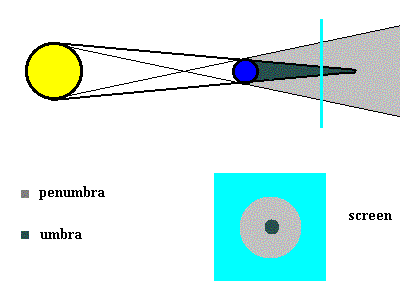
The size of each zone depends on your location (animation)
The animation above shows that the size of each shadow zone changes as you move the screen. When you move the screen to the left, the umbra gets bigger and the penumbra gets smaller. As you move the screen to the right, the umbra shrinks and penumbra grows. If the screen moves far enough to the right, the umbra disappears altogether.
Now that you understand the nature of these shadows, it is possible to consider the two different kinds of eclipses in detail - lunar and solar.
A lunar eclipse can only occur on the night of a full moon ... and only when the moon interacts with the earth's penumbra and/or umbra.
This is the most spectacular type of lunar eclipse. During a total lunar eclipse, the moon goes entirely within the earth's umbra.
|
Total Lunar Eclipse taken on 1-20-2000. The top image shows the moon just entering the umbra. The next images are over-exposed as the moon is entirely in the umbra. |
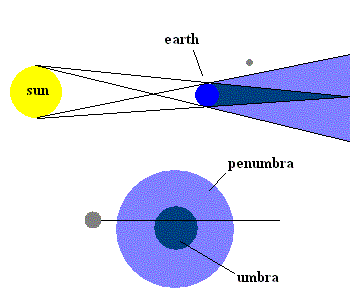 Total Lunar Eclipse (animation) |
There are two other kinds of lunar eclipses, partial and penumbral. If the moon enters the earth's umbra but not completely, the eclipse is known as a partial lunar eclipse. The umbra casts a distinct curved shadow on the moon, which is well worth the effort to observe. If the moon enters the penumbra, but never enters the earth's umbra, the eclipse is known as a penumbral eclipse. This may occur, and you might not even notice it. The only indication might be a slight dimming of the moon over the course of several hours. I wouldn't even get out of bed to observe this.
|
Partial Lunar Eclipse |
Penumbral Eclipse (Yawn!) |
You don't need any special equipment to safely observe a lunar eclipse ... you only need the moon in your local horizon. Lunar eclipses only occur during a full moon ... which is always 180 degrees from the sun. If the sun is down (below the horizon) ... the full moon is visible (above the local horizon).
http://aa.usno.navy.mil/data/docs/LunarEclipse.html
A solar eclipse can only occur on the day of a new moon, when the moon's shadow interacts with observers on the earth. There is a very peculiar coincidence which is found in our solar system at this time. Both the sun and the moon take up the same angular size (about ˝ degree) in the sky as seen from the earth. You already know that the sun is many times bigger than the moon. So how can they appear the same size in the sky? This, of course is a result of their distance from the earth.
These two coins also appear about the same size in this view.
Due to tidal interactions with the earth, the moon appeared much bigger in the sky (in the past) than the sun because it was much closer to us. In the future, the moon will appear smaller than the sun because tidal forces are moving the moon farther away from the earth. Right now, they appear the same size. As a result of this coincidence, the very tip of the moon's umbra just barely reaches the earth (and sometime doesn't because of the elliptical orbit of the moon). This means that at the present distance, the umbra is very small, and the penumbra is rather large. Consider the diagram below.
Solar Eclipses (definitely not to scale)
If an observer was at point "A", they would see the sun just as we see it every day. However, an observer at point "B" would be observing a partial solar eclipse (they are in the moon's penumbra).
courtesy http://science.msfc.nasa.gov/ssl/pad/solar/suntime/talk2.htm
Partial Solar Eclipse
An observer at point "C" would have an opportunity to witness one of nature's greatest treats, ... a total solar eclipse. I was fortunate enough to have witnessed one from Austria on August 11, 1999. For two minutes, the day turned into night at around noon as the moon completely blocked the sun. Of course, you have to be in the moon's umbra to observe this. From any single location on the earth, the sun is totally eclipsed for just a few minutes at most (the maximum possible duration is just about 7 minutes) ... but what a thrill! On August 21, 2017 the US was treated to a great solar eclipse.
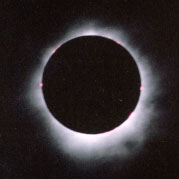 Total Solar Eclipse taken August 11, 1999 |
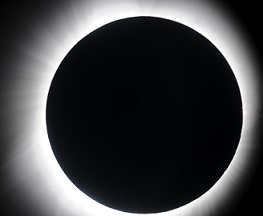 Total Solar Eclipse taken August 21, 2017
|
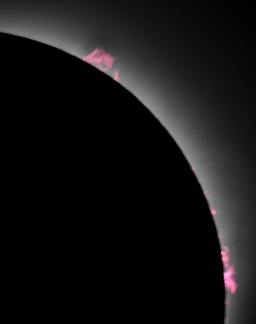 Total Solar Eclipse taken August 21, 2017 Notice the prominences at the limb (way cool!!!) |
I made a movie simulation of the eclipse in 1999 but the file size is large. .wmv format (13 MB) or .mp4 format (18 MB). NASA even took a picture of the umbra from space (see below).
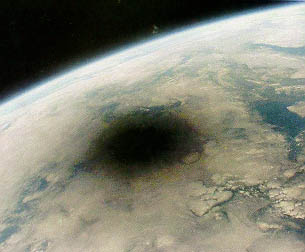
The umbra as seen from space
courtesy NASA
Total solar eclipses gave earlier astronomers a chance to view and study layers of the sun which are normally obscured by the much brighter layer known as the photosphere. The pictures I took (above) show the outer layer of the sun known as the corona. Modern tools now let astronomers study these upper layers of the sun anytime.
Don't worry, if you missed the eclipse across the US on August 21, 2017, you can always catch another one. Click here to see where some future total solar eclipses can be seen from. In most cases, you will have to travel quite a bit to catch a total solar eclipse. Below are some maps which show future total solar eclipses visible from North America. The blue areas are known as the eclipse path or "path of totality". It represents the places the umbra will sweep across the surface. I was in Oregon on August 21, 2017 .... just east of the Cascade Mountains (which is a desert area and least likely to be cloudy). You will notice that the next total solar eclipse visible in North America occurs on April 8, 2024. Please make a point of being somewhere on this path which moves from Texas to Maine. Really lazy? Then just wait until September 14, 2099 and you can witness a total solar eclipse in Milwaukee.
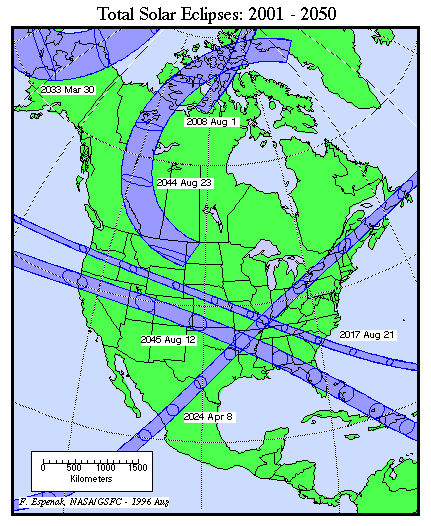 Wow, southern Illinois hit the eclipse jackpot! |
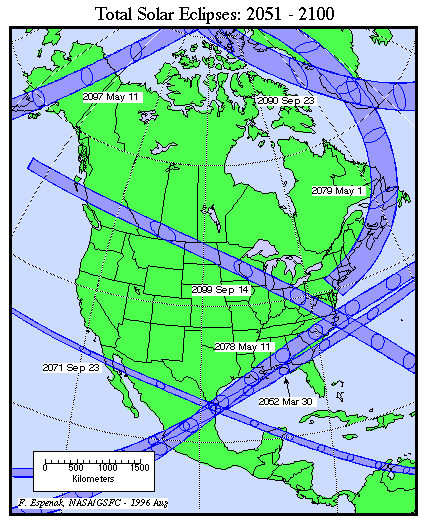 |
Eclipse Predictions by Fred Espenak, NASA/GSFC
There is a third type of solar eclipse known as an annular eclipse (which does not occur every year as the name suggests). On May 10, 1994 I took my entire astronomy class to central Illinois to witness the following:
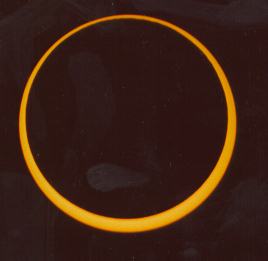
An annular eclipse.
This rare eclipse occurs when the moon is close to its apogee (farthest from the earth) .... making its angular size too small to cover the disk of the sun (known as the photosphere).
Annular Eclipses
If an observer is located at the small red dot (called the antumbra), they will observe an annular eclipse.
You are warned from a very early age never to look directly at the sun. So how can you view a solar eclipse safely? There are several ways.
A cheap pinhole camera
Another cheap way of safely observing an eclipse is to purchase #14 grade welders glass. If you have a few extra dollars, buy the #14 gold glass (which makes the sun appear yellow instead of green and still is less than $10). You can even buy eclipse glasses online at places like this.
If you own a telescope, binoculars, or camera you also need to have a quality solar filter to block out harmful light. Older telescopes were once equipped with a solar filter which attached directly to the eyepiece. If you have one of these older solar filters - do not use it. They have proven to be ineffective and unsafe. Do not use anything homemade to view the sun (except the pinhole camera mentioned above) ... buy a filter from a reputable dealer and enjoy the eclipse safely.
The moon orbits the earth on a plane which is titled about 5 degrees with respect to the plane that the earth orbits the sun (the ecliptic). Because of this slight tilt, eclipses do not occur at every new or full moon. Study the diagram below carefully. It shows the earth at 4 different locations in its orbit around the sun. At each location the moon is placed at the new and full positions. It should be clear why you would not expect to see any kind of eclipse when the earth is at positions "A" or "C" because the shadows do not interact. That is, when the moon is new, its shadow misses the earth, so no solar eclipse occurs, and when the moon is full, the shadow of the earth misses the moon making a lunar eclipse impossible.
This drawing is not to scale.
Now look at the earth when it is at locations "B" or "D". You can see that these positions provide a favorable alignment and you can expect to see either a solar eclipse or lunar eclipse then. Astronomers say the full and new moon are at the "nodes" ... where the moon's orbital plane crosses the ecliptic.
Below is a chronological list of all eclipses from 2000 to 2018, visible from somewhere on the earth. All dates are at mid eclipse universal time (UT). How good are you at finding any patterns in this data?
|
Lunar 01/21/2000 Solar 02/05/2000 Solar 07/01/2000 Lunar 07/16/2000 Solar 07/31/2000 Solar 12/25/2000 Lunar 01/09/2001 Solar 06/21/2001 Lunar 07/05/2001 Solar 12/14/2001 Lunar 12/30/2001 Lunar 05/26/2002 Solar 06/10/2002 Lunar 06/24/2002 Lunar 11/20/2002 Solar 12/04/2002 Lunar 05/16/2003 Solar 05/31/2003 Lunar 11/09/2003 Solar 11/23/2003 Solar 04/19/2004 Lunar 05/04/2004 Solar 10/14/2004 Lunar 10/28/2004 Solar 04/08/2005 Lunar 04/24/2005 Solar 10/03/2005 Lunar 10/17/2005 |
Lunar 03/14/2006 Solar 03/29/2006 Lunar 09/07/2006 Solar 09/22/2006 Lunar 03/03/2007 Solar 03/19/2007 Lunar 08/28/2007 Solar 09/11/2007 Solar 02/07/2008 Lunar 02/21/2008 Solar 08/01/2008 Lunar 08/16/2008 Solar 01/26/2009 Lunar 02/09/2009 Lunar 07/07/2009 Solar 07/22/2009 Lunar 08/06/2009 Lunar 12/31/2009 Solar 01/15/2010 Lunar 06/26/2010 Solar 07/11/2010 Lunar 12/21/2010 Solar 01/04/2011 Solar 06/01/2011 Lunar 06/15/2011 Solar 07/01/2011 Solar 11/25/2011 Lunar 12/10/2011 |
Solar 05/20/2012 Lunar 06/04/2012 Solar 11/13/2012 Lunar 11/28/2012 Lunar 04/25/2013 Solar 05/10/2013 Lunar 10/18/2013 Solar 11/03/2013 Lunar 04/15/2014 Solar 04/29/2014 Lunar 10/08/2014 Solar 10/23/2014 Solar 03/20/2015 Lunar 04/04/2015 Solar 09/13/2015 Lunar 09/28/2015 Solar 03/09/2016 Lunar 03/23/2016 Lunar 08/18/2016 Solar 09/01/2016 Lunar 09/16/2016 Lunar 02/11/2017 Solar 02/26/2017 Lunar 08/07/2017 Solar 08/21/2017 Lunar 01/31/2018 Solar 02/15/2018 |
Two week pattern
Actually, an eclipse can occur anytime the earth is close to position "B" or "D" (see diagram above). This means there is an short interval in time (which astronomers call the eclipse season) when you can expect eclipses. Since it takes about 2 weeks for the moon to go from new to full, eclipses usually occur in pairs, where a solar eclipse is followed by a lunar or vice versa.
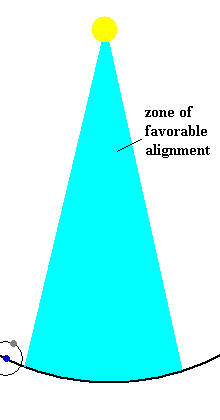
2 week eclipse cycle (animation)
Note: sometimes you can even catch 3 eclipses within this "window of opportunity". For example, the data above shows eclipses on the following dates:
Solar
07/01/2000
Lunar 07/16/2000
Solar 07/31/2000
Six month pattern
The diagram above should convince you that six months after one batch of eclipses, you will get another "eclipse season" ... when the earth is at positions "B" and "D" in the diagram. You should also be able to see that pattern in the data listed above.
The Saros Period
The ancient Chaldeans discovered a cycle in the eclipse pattern by examining centuries worth of data. They discovered that eclipses reoccur every 6,585.3 days (or about 18 years and 10 days). This is an absolutely amazing feat since not every eclipse was visible from their local horizon. As I said before, I witnessed a total solar eclipse in Austria on August 11, 1999, but you already know that there was another total solar eclipse over the US on August 21, 2017 ... exactly one saros cycle later (but you had to be a world traveler to discover this from observation). The next one in the cycle (known as saros 145) will be over Japan on September 2, 2035.
Why this occurs is a bit tricky to explain .. so here goes (which will not be on any test).
If you examine the eclipse data carefully, you will see that the "eclipse season" does not occur exactly at the same times each year, but slowly occurs earlier each successive year (averaging about 20 days earlier each year). It's as if the "zone of opportunity" is migrating slowly as time progresses (known as a draconic month).

Animation
This is because the plane of the moon's orbit "wobbles" as time progresses. Take a coin out of your pocket and drop it on a table. Ever so often, the coin "wobbles" before it comes to rest. This is exactly what happens to the orbital plane of the moon. As a result, the eclipse season changes from one year to the next. In addition, the moon's orbit is an ellipse, but that also changes in space. You know from the last section, the full moon can sometimes be at apogee (and appear small) or at perigee (and appear big). This is yet another "cycle" (known as the anomalistic month) that must be taken into account. Finally, there are the cycles of phases which tells us there can only be a solar eclipse when the moon is full (synodic month). Put all these cycles together and it takes 6,585.3 days for everything to come back to square one.
Sometime one object "hides" behind another object in an event known as an occultation.
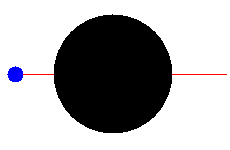
The blue object is being occluded by the black object (animation).
Sometimes the moon occludes a bright star or even a planet. This is an interesting event, but other than that, can an occultation serve any useful purpose?
The answer is yes! When we study stars, we will show how eclipsing binary systems can reveal a lot of information about the stars in the system. For now, let me give one example of how an occultation event can be useful. Pluto was discovered in 1930, but only as a small point of light of a photographic negative. It was too small to show up as a disk, even when more powerful telescopes were constructed later. The latest generation of telescopes can now resolve Pluto to a disk, but astronomers already knew the size of Pluto because, on occasion, it would occlude a distant star. The duration of the occultation depended on several factors, such as the orbital speed of Pluto (known), the path of the occultation across the disk of Pluto, and the diameter of Pluto itself. By timing several of these events, astronomers knew that the longest occultation had to occur when the star traversed across the diameter of Pluto. This event led astronomers to "work backwards" and estimate the physical size (diameter) required to produce the necessary duration.
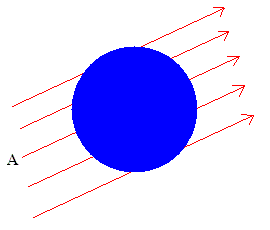
The occultation across path "A" would last the longest. Imagine how the duration of the occultation would change if the blue disk were much bigger (or smaller). This same technique is being used to determine the size of objects even more distant than Pluto that have been discovered in great numbers since 1992.
I have a short movie demonstrating several examples of occultations - .wmv format (1 MB) or .mp4 format (1 MB)
If a small object crosses in front of larger object, the event is known as a transit.

This is a transit of the blue object across the black object (animation)
Transit of Venus (across the sun) 6-8-2004
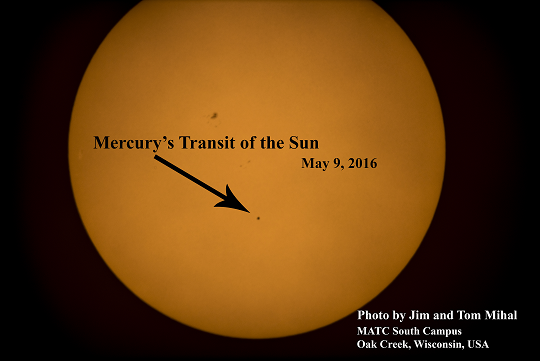
Transit of Mercury 5-9-16 (the next one is 11-11-19)
There was a transit of Mercury across the sun on 5-9-2016 and transits of Venus on 6-8-2004 and 6-5-2012. Besides being very rare, the transit of a planet across the sun can yield some valuable information. Sir Edmund Halley observed a transit of Mercury in 1677 and realized that by observing the exact duration of any transit, one could accurately determine the value of the earth-sun distance (the size of an AU). He called for future astronomers to observe the transits of Venus in 1761 and again in 1769. The transit of 1761 produced no results, but the transit of 1769 allowed astronomers to determine the size of an AU to great accuracy. This, in itself, is a very interesting story and will be left as a future discussion in this class (either the discussion board and/or astronomy lab class).
Sorry, but you missed all the transits of Venus in your lifetime. However, there are opportunities to witness a transit of Mercury in the near future.
Watch a transit of Mercury on May 9, 2016 - .wmv format (2 MB) or .mp4 format (2 MB).
Watch moons Ganymede and Io move around Jupiter - .wmv format (1 MB) or .mp4 format (1 MB).
Even rarer, in 2013 Curiosity watched an occultation of Deimos by Phobos (two small moons orbiting Mars) ... pretty cool, eh?
 Credit: NASA / JPL-Caltech / Malin Space Science Systems / Texas A&M
University
Credit: NASA / JPL-Caltech / Malin Space Science Systems / Texas A&M
University
If an ant crawled across the front glass of your car's headlight, could you tell it was there? That is pretty much how astronomers are now able to discover planets around other stars.
One technique astronomers use in their quest to discover planets around other stars (exoplanets) involves transits. If a star has a planet going around it and the orientation in space allows a transit, astronomers are able to detect it by examining small changes in the light intensity (during the transit). During the transit, a small amount of light will be blocked from our line of site. When a regular pattern develops over time, it provides convincing evidence that the planet exists. Many planets beyond our solar system have already been detected using this technique (transit method). The actual numbers change almost on a weekly basis so I hesitate to give exact figures but the number is in the thousands. Click here for the latest data.
The Kepler Telescope is a spacecraft that examines (simultaneously) over 100,000 stars in the constellation Cygnus (in an area about the size of the full moon). Kepler reached orbit in 2009 but was declared "dead" in 2013 but fixed by clever space engineers. The ultimate goal would be finding a planet going around a star in the "goldilocks zone" ... not too close .... not too far from the star it orbits. Can we find an "earth twin" in our lifetime? Watch for the launch (scheduled for 2018) of the Transiting Exoplanet Survey Satellite (TESS).
Using the "wobble method" (discussed in the last unit), astronomers have discovered "Hot Jupiters". That is, extremely massive planets orbiting very close to their parent star. The transit method is finding a new class of planets nicknamed "Super Earths". This class includes any planet up to about ten times the size of the earth. Keep in mind that the transit method allows us to obtain the physical size of the exoplanet. The larger the planet, the more light it blocks during the transit. By observing the orbital mechanics of these exoplanets, we can obtain the mass. With knowledge of both the mass and size of the planet, we can derive the density (how compact the mass is). That is, we can tell if these planets are rocky or gassy. The next step is to find earth's twin. Now that is exciting!!! We leave that topic for a future discussion question.
ŠJim Mihal 2004, 2014- all rights reserved